In this discussion, we will delve into the world of Cluster Setting and provide you with a comprehensive understanding of its characteristics. Cluster settings have gained recognition and popularity among diamond and jewelry enthusiasts for their unique appeal.
If you desire a piece of jewelry that exudes vintage charm and enhances your overall aesthetic, a cluster-set ring design is an excellent choice. To fully grasp the intricacies of cluster settings, we will explore various aspects such as the definition of a cluster set engagement ring, the historical significance of cluster settings, considerations of price and value, as well as the advantages and disadvantages they offer.
Prepare to embark on a journey to discover the fascinating world of Cluster Settings and gain comprehensive knowledge about their features and significance.
DESIGN YOUR OWN ENGAGEMENT RING: START WITH A SETTING OR START WITH A DIAMOND. IT’S REALLY UP TO YOU!

What Are Cluster Settings?
Clustered jewelry settings offer a captivating touch to any outfit, making a statement throughout the year. These settings typically feature multiple precious or semi-precious gemstones arranged in close proximity.
A common design in cluster settings involves surrounding a larger stone with smaller diamonds, creating the illusion of a larger centerpiece. Engagement rings often showcase cluster settings, incorporating unique and distinctive shapes desired by each couple. Cluster rings can also feature a collection of smaller diamonds arranged together.
Cluster rings are generally more affordable compared to solitaires, as they are simpler to create. Many of the smaller diamonds used in clusters are crafted from shattered fragments of larger diamonds, adding a touch of sustainability to these designs.
The diamonds in a cluster ring often form geometric shapes or distinctive patterns, such as a flower. This imparts an antique charm to the overall look of the ring. Round diamonds are commonly used in cluster settings, especially in lower carat weights.
Cluster engagement rings tend to be attention-grabbing, as the small stones complement each other, creating a sparkling effect. They are particularly favored by individuals seeking a unique piece that exudes character and individuality.
When choosing a cluster setting, it is essential to ensure the smaller diamonds are securely and evenly placed to achieve a symmetrical pattern. Thus, selecting a reputable jeweler is crucial to obtain exceptional craftsmanship and quality at a reasonable price.
Key Characteristics of Cluster Settings:
- Unique Appeal: Cluster settings possess a captivating factor that tends to attract attention due to their distinctiveness.
- Sparkling Brilliance: These settings have a remarkable ability to reflect light from various angles, resulting in an intensified sparkle.
- Versatility: Cluster settings offer opportunities for customization, allowing for experimentation with different gemstone colors, sizes, and combinations, catering to those seeking a truly unique piece.
- Timeless Charm: Cluster rings carry a sense of wisdom and antiquity, making them timeless treasures that can be cherished for years to come.
- Carat Weight Optimization: Cluster settings provide an excellent option to achieve a higher carat weight at a fraction of the cost of a solitaire ring. While featuring smaller gemstones, cluster rings offer an affordable alternative without compromising on beauty.
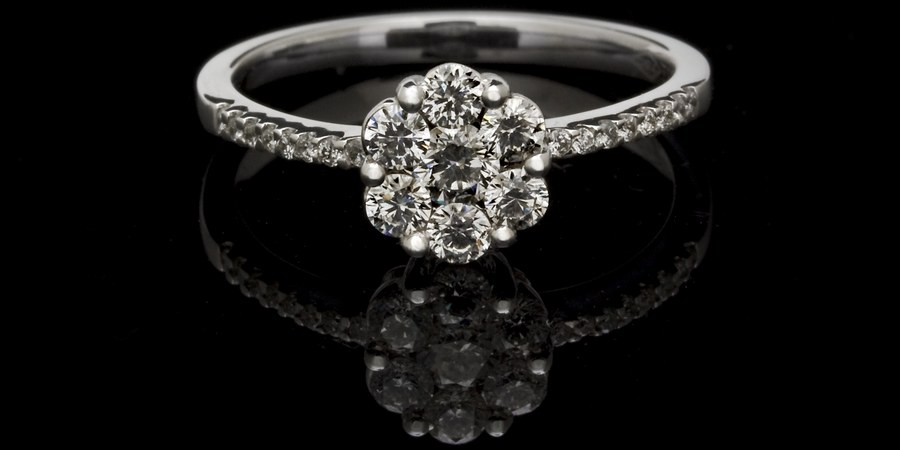
History of Cluster Settings Rings
Cluster rings have a captivating history that traces back to Georgian design. In the earliest cluster rings, known as Georgian clusters, an oval gemstone was surrounded by smaller diamonds, creating a distinctive look. These Georgian masterpieces were characterized by their use of gold and blackened silver, showcasing the craftsmanship of the time.
The Victorian era brought a shift in cluster ring design during the 1830s. Victorian cluster rings featured larger diamonds and exuded the typical flair of the era. Diamonds were often paired with large sapphires, while rubies gained popularity as prominent focal points in these magnificent creations.
The 1920s witnessed the rise of cocktail rings in prohibition America. During this time, when alcohol was prohibited, clandestine cocktail parties became a regular occurrence. The stylish women of the era showcased their glamour with shorter hair, plunging necklines, and Art Deco jewelry at these gatherings.
The cluster ring, with a striking, colorful gemstone at the center surrounded by sparkling diamonds, became the go-to ring for these cocktail parties. The term “cocktail ring” emerged from this trend, representing the statement pieces worn while indulging in a whiskey sour or other cocktails of the time.
Thus, the history of cluster rings encompasses the elegance of Georgian design, the opulence of Victorian influences, and the glamorous association with 1920s cocktail parties, giving these rings a rich and fascinating heritage.
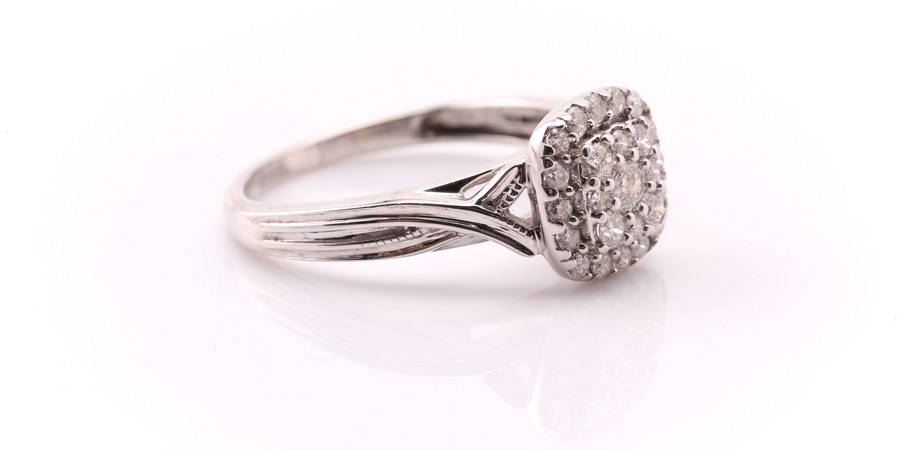
How to Identify Cluster Ring Setting?
Diamond clusters are often created using round brilliant-cut diamonds that are set in prongs. However, designers also utilize various diamond shapes, such as ovals, in the creation of designer diamond cluster earrings and diamond cluster engagement rings.
Prong settings are favored by jewelers because they allow for the placement of stones side by side. Shared or standard prongs are commonly used as they require the least amount of metal. This minimal use of metal highlights the smaller diamonds, maximizing the fire and brilliance of each stone. As a result, the cluster of diamonds gives the illusion of a single, larger diamond rather than multiple smaller ones assembled together.
Clustering is particularly prevalent in gemstone jewelry, often seen in floral designs as mentioned in our previous history chapter. Additionally, a notable feature of this arrangement is the presence of a larger center stone surrounded by smaller diamonds. In designer jewelry, multiple designs may be incorporated while still maintaining emphasis on the focal stone.
Compared to a solitaire diamond of the same carat weight, clustered diamonds occupy a larger overall area within the piece of jewelry. The reason behind this lies in the spacing between the multiple tiny diamonds.
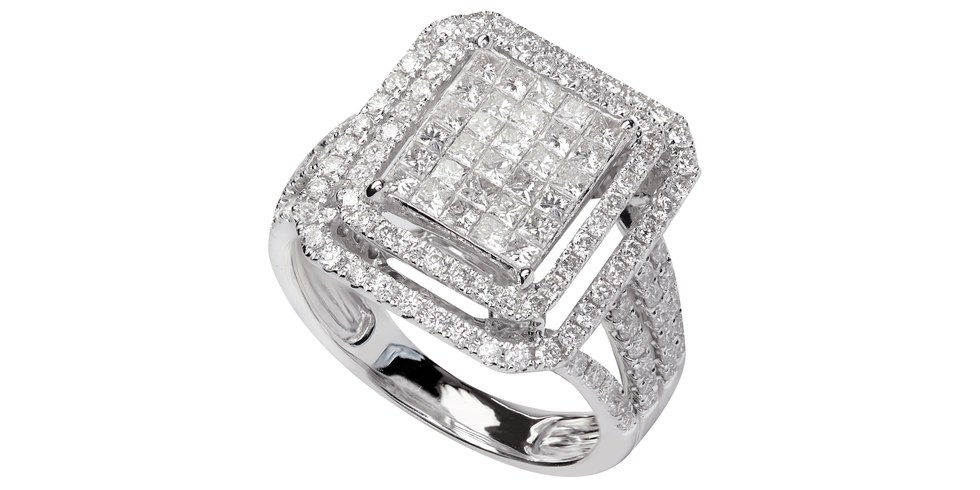
Pros of Buying Cluster Setting Rings
One advantage of choosing a cluster ring is the cost-effective impact of a large stone.
If you prefer to spend your hard-earned money on things like a new porch or a vacation to Bali or Thailand rather than investing in a large diamond, but still desire a ring that creates a stunning impression, a cluster ring may be the perfect choice for you.
After all, you may be able to afford a 2-carat total weight cluster ring when a 2-carat single stone ring is out of reach. Remember, smaller diamonds are less expensive.
Purchasing 20 tiny diamonds for a cluster ring will be far more affordable than buying a single 2-carat diamond, allowing you to allocate more funds to enjoy experiences like swimming with fishes in Bali or Thailand.
What we find particularly fascinating about cluster set diamond rings is their ability to quickly generate a captivating old or antique atmosphere.
If you’re aiming for a vintage look, the cluster setting could be the ideal option for you. Cluster diamond rings can exhibit a stunning mid-century or art deco style, especially when combined with additional metal embellishments on the gold band, resulting in a truly unique ring.
Don’t hesitate to experiment not only with the shape of the diamonds but also with the overall shape of the cluster. A skilled jeweler or ring designer can maximize the beauty based on your finger shape, creating something truly special for you.
Now, let’s recap some of the pros:
- Cluster settings make a great first impression.
- They appear larger and draw attention due to their shine and shimmer.
- They possess a timeless charm.
- They offer easy adaptability, allowing customization of stones, sizes, and configurations.
- They have a distinct aesthetic and a vintage flair, adding dimension and texture to the ring.
- They are often more affordable than other types of rings with larger gemstones.
- Cluster rings can be personalized to hold deep meaning, such as representing different family members with multiple diamonds or gemstones.
Now, let’s address a few cons of cluster setting rings:
- Maintenance can be a concern due to the number of prongs holding the diamonds. More prongs mean a higher risk of diamonds getting knocked loose from the ring.
- Proper placement of each diamond is crucial, as even a tiny mistake can lead to damage.
- Finding a wedding ring that complements the size and style of a cluster setting may be challenging.
- Resizing can be difficult, and there is a risk of diamonds shattering or chipping during the process.
- Cluster rings have small spaces where dust and debris can accumulate, making them harder to clean and maintain their shine.
- Due to the small size of clustered diamonds and gemstones, they can become loose and fall out if the ring is not properly cared for.
- Cluster rings are not as common as other ring styles, so it’s important to ensure that your prospective spouse loves the design before proposing with one.
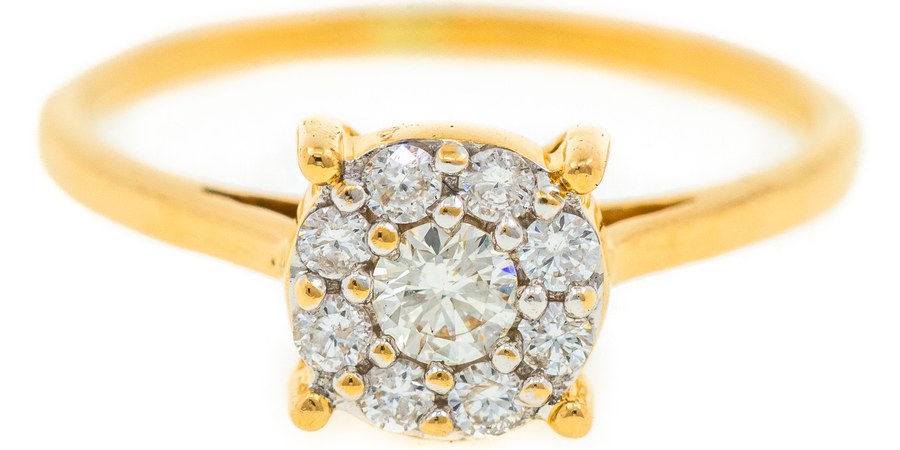
Cluster Setting Rings vs. Solitaire Setting Rings
Cluster diamond rings consist of multiple smaller diamonds arranged together, while solitaire rings feature a single large central stone. Solitaire rings are typically made with a solitary diamond.
Compared to solitaire rings, cluster rings are often more affordable because they do not feature a large diamond. The price of a cluster ring depends on factors such as the quality, carat weight, and precious metal used in the diamonds. Since the carat weight is distributed among several smaller diamonds in a cluster ring, it tends to be less expensive than a solitaire ring.
It’s important to note that when choosing a diamond ring, the price increases significantly with larger carat weights. A two-carat diamond does not cost twice as much as a one-carat diamond.
Solitaire settings attract less dirt and debris since they have only one diamond, requiring less frequent cleaning and maintenance compared to cluster rings.
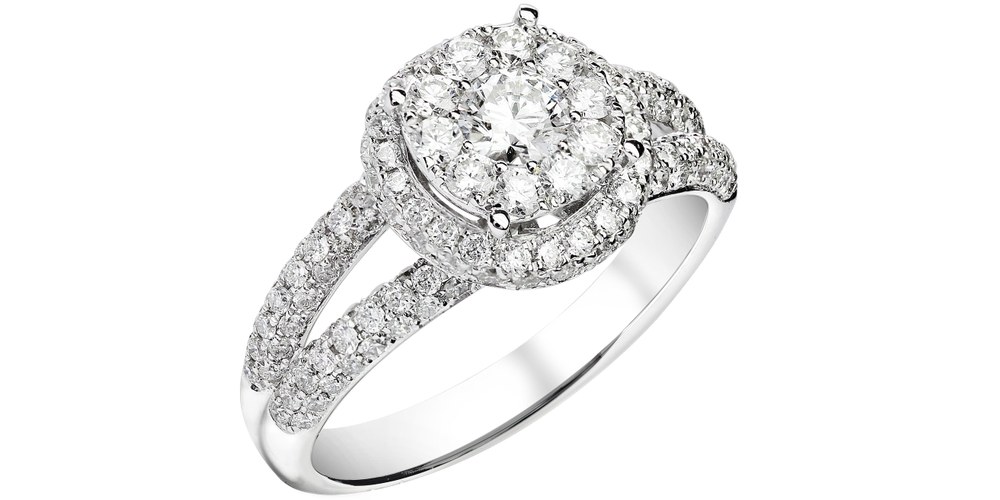
Cluster Diamond Setting vs. Halo Settings
Both halo and cluster settings offer unique options for engagement rings, and the choice ultimately depends on personal preferences and specific requirements.
To help you make a decision, consider the following factors: durability, symbolism, and the ring designs that complement each setting.
A halo setting features a single large diamond surrounded by smaller gems, creating a streamlined and modern look. On the other hand, a cluster setting consists of a larger central stone surrounded by smaller diamonds or an arrangement of stones of similar size, exuding a vintage-inspired aesthetic.
The halo setting provides added protection to the center stone, preventing it from snagging or chipping. In contrast, cluster diamonds or gemstones may not be as neatly placed and could potentially snag if not handled with care.
Symbolically, a diamond halo ring represents everlasting love, while a cluster setting symbolizes the coming together of individual diamonds or stones, signifying unity.
In terms of appearance, the halo setting creates a clean ring-like effect around the focal stone, whereas the cluster setting creates a more intricate and crowded pattern.
When it comes to cost, opting for a single large diamond surrounded by smaller ones in a halo setting can be a cost-effective choice. Conversely, a cluster setting with a collection of larger diamonds or gemstones may be relatively more expensive. Both settings work well with various types of gems, diamonds, and metals.
Consider these factors when making your decision to ensure you choose the setting that aligns with your preferences and budget.
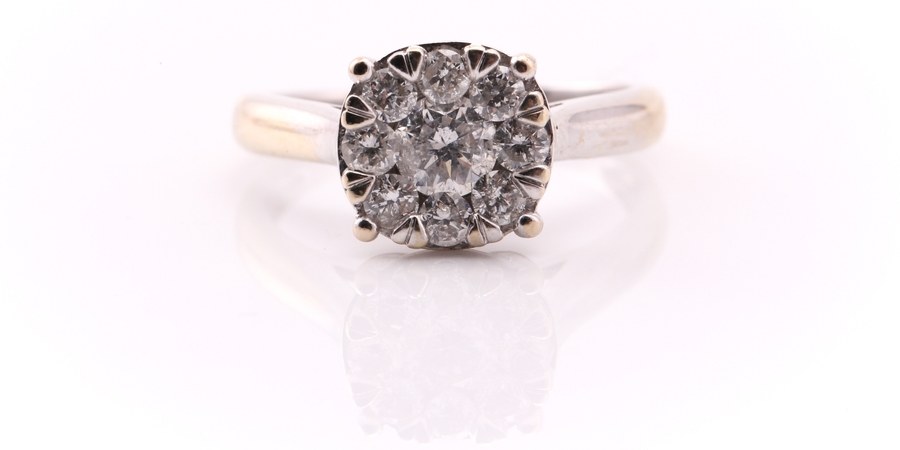
Cluster Setting Rings Cost
Price is often a significant factor when purchasing an engagement ring, and there are ways to keep the cost within your budget regardless of the ring setting you choose.
In the case of a traditional halo engagement ring, which features a larger central stone surrounded by smaller diamonds, the key factors influencing the overall cost are the carat weight, clarity, color, and cut of the center diamond or gemstone. By opting for a halo ring with a lower carat weight or choosing diamonds with slightly lower clarity or color grades, you can find options that fit a wide range of budgets.
Cluster engagement rings, on the other hand, may include larger diamonds or gemstones, which can drive up the price. However, you can still find more affordable cluster engagement rings by carefully considering the design of the ring. For example, selecting a cluster ring with smaller stones or focusing on a prominent center stone can help lower the cost. Additionally, expanding your options to include different diamond cuts, clarities, and colors can provide more affordable alternatives.
It’s important to note that the cost of diamond cluster rings, like any other type of ring, can vary. On average, diamond cluster rings range in price from $1,000 to $15,000, depending on factors such as the grade and carat size of the stones, as well as the intricacy of the mounting.
By being mindful of these considerations and exploring different options, you can find an engagement ring that suits your budget without compromising on style or quality.
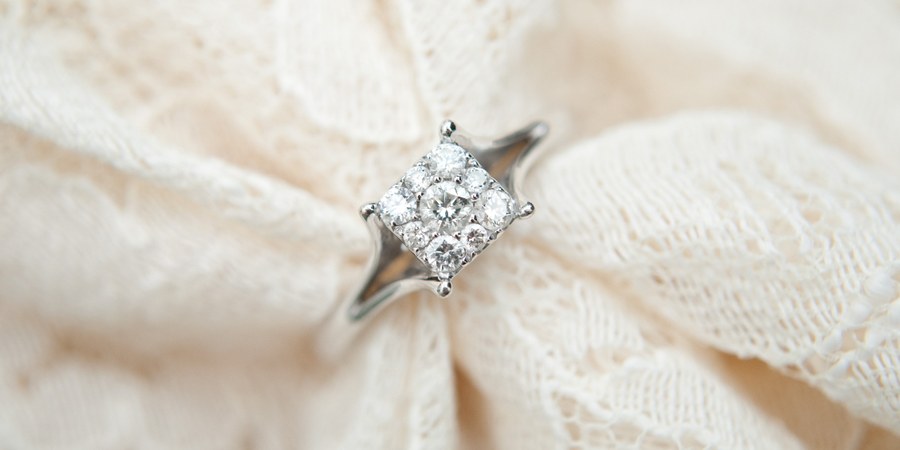
A Mini Buying Guide For Cluster Setting Rings
In addition to the advantages and disadvantages discussed earlier, there are a few more factors to consider when buying a cluster setting ring, especially if you intend to use it as an engagement ring. Keep the following two recommendations in mind to ensure you get the most stunning ring at the best price:
- Evaluate Carat Weight Calculation:
Before making a purchase, inquire about how the jeweler determines the carat weight of the cluster ring. While most reputable jewelers will provide accurate information about the carat weight, some dishonest sellers may include the weight of the cluster diamonds in the total carat weight to inflate the price. Make sure you understand how the carat weight is calculated and verify the accuracy of the information provided. - Carefully Inspect the Ring:
Cluster rings may not always be well-made, and the smaller stones may not be properly secured in their settings. If you end up with a poorly constructed ring, there is a high risk of losing many of the smaller stones after a few bumps or sudden movements. Before making a purchase, carefully examine the ring. You can even hold it up to your ear and gently shake it to listen for any rattling sounds. If you hear rattling, it indicates that one or more stones are not securely set. In such cases, consider looking for another ring or ask the jeweler if they can ensure the stones are properly secured. If a jeweler is willing to sell a potentially damaged ring, it may be a sign to seek out a different jeweler to find the perfect engagement ring.
By being cautious about carat weight calculations and thoroughly inspecting the ring before purchasing, you can avoid potential issues and find a cluster setting ring that is both beautiful and durable for your engagement.
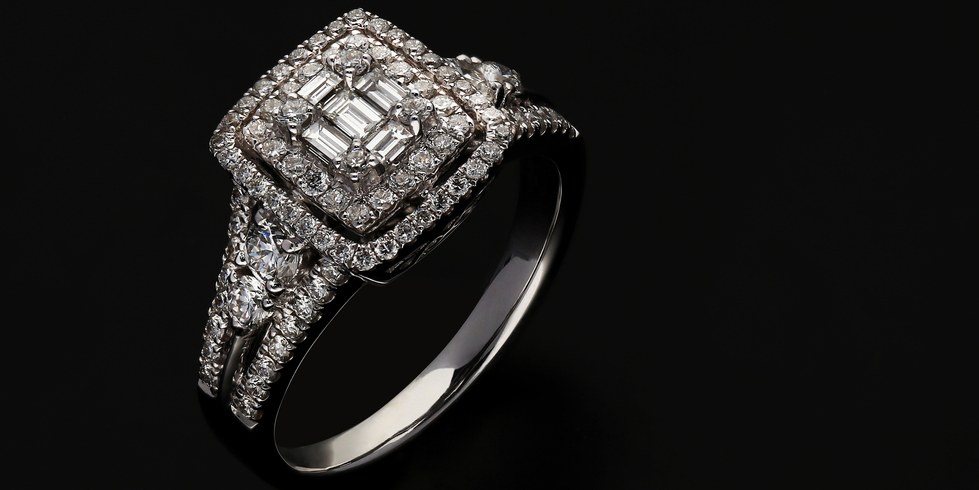
Cluster Settings – Frequently Asked Questions (FAQ)
What Exactly Is a Cluster Ring?
A cluster ring is a type of ring that features a central diamond surrounded by a circular halo of smaller diamonds. The arrangement of the diamonds in the cluster gives the illusion of a single large diamond.
Are Cluster Rings Unappealing?
High-quality cluster rings, made with brilliant diamonds and fine metals, are not considered tacky. Like any other ring setting, it’s important to look for a well-crafted cluster ring to ensure its appeal.
Are Cluster Engagement Rings Modern and Fashionable?
While cluster engagement rings may not be the most popular choice, they can be modern and fashionable. They are particularly well-suited for couples on a budget who want a unique and distinctive ring. Cluster ring styles range from classic designs with halos to three-stone cluster diamond rings.
Do Diamond Cluster Rings Cost Less Than Others?
Cluster rings often cost less than other ring shapes due to the smaller carat weight of the diamonds. This makes cluster rings a more affordable option, especially for those seeking a unique ring style.
What Are the Benefits of a Cluster Set Engagement Ring?
In addition to the traditional options, cluster diamond settings offer the advantage of unique and distinctive designs. Cluster engagement rings can be a beautiful alternative to traditional solitaire engagement rings, offering a significant cost savings.
Do Cluster Rings Shine Brighter Than Others?
Cluster rings can outshine solitaire rings in several ways, including having more stones, excellent brilliance, and intricate designs.
What Is the Value of a 1-carat Cluster Diamond Ring?
In brick-and-mortar stores, a high-quality 1-carat diamond cluster ring can range in price from $6,500 to $7,500. However, purchasing the same diamond online can result in a lower price range of $3,000 to $4,000.
Are Cluster Rings Fashionable?
Cluster rings, characterized by a central diamond surrounded by a circular halo of smaller diamonds, have seen periods of fashion popularity, with the most recent wave occurring around 2010. The distinctive arrangement of the diamonds is one of the defining features of cluster rings.

Final Thoughts
In conclusion, the cluster setting is a remarkable choice for those seeking a jewelry piece that combines historical charm with personal style. Throughout this post, we compared cluster settings to other popular options like solitaire and halo, highlighting their advantages and disadvantages. We also aimed to address common questions and provide clarity on the topic.
We sincerely hope that this discussion has expanded your knowledge and understanding of these unique and beautiful ring settings. Thank you for joining us in exploring this fascinating subject!


